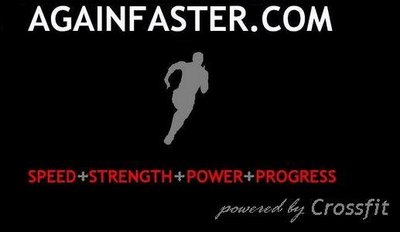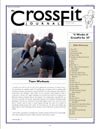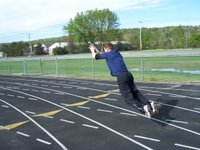Tracking School
Keeping a workout log is not sexy. It’s not as much fun as a heavy deadlift or a smartly executed jerk, so most of my athletes refuse to do it. This is my fault.
I beg and cajole and make a complete mockery of any man, woman, or child who is unable to quote their one-rep maxes or previous personal records from memory, but I never actually force anyone to record their workouts, a process that would speed up recollection significantly.
As a result, I often have athletes spinning their wheels while we try to figure out reasonable loads and modifications for any given workout. Clearly, this is unacceptable.
In leiu of purchasing a cattle prod, I’m going to try to reason with them—and by extension—you. There are at least a few dozen good reasons to complete a log, and you’re going to learn about a few of them today.
Even if you are diligently recording every squat, pull-up, thruster, and sprint, you’re not doing it right. Data in and of itself is useless. It must be qualified and analyzed if it’s going to do you (and your instructor) any good. For this reason, I’m going to share a few metrics that will make your log a lot more useful.
The first step to keeping an effective log is to get rid of your computer. The internet has given us blogs and websites and forums, all of which allow an athlete to store workouts and times in digital format. Many of you have undoubtedly embraced this technology and all the attendant bells and whistles that come along with it, like calorie counters and food logs. Good for you!
Now turn that damn thing off.
When was the last time you had your laptop next to the platform? Ever try to check a personal record online while your hands are covered in chalk and the sweat is pouring off your forehead? I didn't think so.
A good notebook and a pen will do just fine. Start by recording the movements, repetitions, loads, and times for your workouts. Record all four of these metrics, regardless of the type of workout you complete. This data is the raw material for later analysis, and must be kept religiously. A word of caution: do this immediately after your workout. A hastily completed entry, written four days after the fact, won’t do you a lick of good. Your notoriously inaccurate mind will betray you at its earliest possible convenience, typically about a half-hour after you leave the gym. This applies to strength workouts as well. Even if you’re flinging around some iron (or in our case, rubber), start a stopwatch and note the time to completion (as well as movements, repetitions, and loads) before you hit the showers.
If you’re one of the folks who read the first paragraph of this article and figured it wouldn’t apply to you, listen up. Your workout log is nothing but a glorified paperweight unless you do something with your data, and it’s only marginally useful with the data you have so far.
In addition to movements, reps, loads, and times, we need three additional pieces of information—subjective intensity, time since last workout, and bodyweight.
Subjective intensity is a personal measure of how difficult the workout was to complete. For our purposes, “today kicked my ass” is inadequate. We need to attach a number to a feeling, and we’ll do this using a Likert scale. You’ve undoubtedly seen these, although you probably didn’t know they had a name. Hospitals use them to assess patient pain levels, and psychologists use them to propagate half-truths and dubious correlations upon the world.
The Likert Scale looks like this:

All you do is pick the number that corresponds with your immediate feelings regarding the workout, and write it down.
Time since last workout should be measured in hours, not days. Given that most serious athletes are working out six or seven times a week, a day-based data set isn’t worth spilling ink over. On the other hand, knowing the number of hours since your last workout provides you with a great way to determine the relationship between subjective intensity, recovery time, and performance. I’ll show you how in a few moments.
Bodyweight is easy. Step on the scale, step off the scale, and write down your weight. You don’t need to do this very often, provided that you are not trying to diet down or bulk up. A rough estimation will do nicely, as long as it’s consistent.
If you’ve followed me this far, you now have seven pieces of information that you’re recording each and every time you set foot in the gym:
1.) Movements
2.) Repetitions
3.) Loads
4.) Time to Completion
5.) Subjective Intensity
6.) Time Since Last Workout
7.) Bodyweight
A typical entry for me might look like this:
5/02/07
Completed: 1 hr, 5 min
Intensity: 6
Time Since Last: 22 hours
BW: 165
Clean and Jerk
5 x 3 x 70% (135)
4 x 3 x 80% (155)
3 x 3 x 90% (170)
1 x 3 x 95% (180)Given this information, I can calculate a few things right off the bat which allow me to determine the objective intensity of the workout. (I stole this calculation straight off the pages of Coach Rip’s new book
“Practical Programming”, if anyone is looking for references and not finding them.)
The first calculation is total volume, or how much weight I moved. Total volume is an aggregate of sets multiplied by reps multiplied by weight.
Set 1: 5 x 3 x 135 = 2025 pounds
Set 2: 4 x 3 x 155 = 1860 pounds
Set 3: 3 x 3 x 170 = 1530 pounds
Set 4: 1 x 3 x 180 = 540 pounds
Total Volume = 5955 pounds
Next, I calculate an average weight per repetition:
5955 pounds/39 reps = 153 pounds/rep
Then, I simply divide average weight per repetition by my 1 rep max, multiply by 100, and come up with an objective measure of the intensity of my workout.
[153 pounds/190 pounds] * 100 = 81%
This little number is incredibly useful when I’m trying to plan my next workout or write a full-out training program, especially when used in conjunction with my subjective intensity measure, my bodyweight, my recovery level, and time to completion.
The key to using these numbers effectively is to have a large data set. You’ll need to accumulate a month or so of data before it will be of any use, and more data is better than less. Follow along with me here.
Let’s say that my above entry was Day One of my training program (it wouldn’t be, but forget that for a minute). Let’s say that the next day, Day Two, I go again hard, and move 6200 pounds in 40 repetitions, coming up with an average weight per rep of 155 pounds and an objective intensity of 82%. My subjective intensity is a 10, and the time since my last workout is 22 hours.
Looking at the relationship between Day One and Day Two, I can see that very little has changed. My objective intensity and average weight per rep is constant, and my rest period hasn’t changed. The only meaningful change is my subjective intensity, which skyrocketed from a 6 to a 10. Referring back to my Likert scale, I’ve moved into the realm of “Ridiculous”.
Being the smart trainer/athlete that I am, I now know that I cannot handle two back-to-back days at ~80% 1RM without a huge jump in subjective intensity. Taking it one step further, I can theorize that my rest period was inadequate. This theory would be bolstered if it took significantly longer to perform the Day Two workout, say an hour and a half rather than 65 minutes. If the larger pattern warranted it, I might even conclude that my program is inappropriate for my experience level, and a less intense program might be necessary.
This is an awfully convenient example. I constructed it out of thin air, so it should be. In reality, you’ll be looking for patterns in the numbers over time that will allow you to evaluate your training status and avoid overtraining, and these patterns might not always be obvious. My example offers a clear indication of too much work in too little time, unless of course, the larger pattern indicates that this amount of stress drives improvement.
If you wanted to take it one step further, you could use this method to evaluate how appropriate any prewritten program is for your skill level. Simply calculate the objective intensity for each workout, the prescribed rest periods between workouts, and see how they relate to your current program. If the Again Faster Workout from Hell operates at an average objective intensity of 85% with 24 hour breaks between workouts, and your current program has an objective intensity of 70% with 36 hour breaks (and is producing results!), the AFWFH is not something you should be doing.
The key to effective training is to keep objective intensity as high as possible while maintaining subjective intensity at manageable levels, simultaneously observing constant increases in one-rep max. Whew. That’s a loaded sentence, and entire books have been written about it (like Rip’s). Keeping a decent log is the first step toward achieving this effective training.
I could interject a whole bunch of platitudes here, but I’ll spare you. Suffice to say that knowing your training history is a prerequisite to effective training, and you’re not going to remember everything you need to know. Write it down, and stop spinning your wheels. If you’re ready for it, do a little math, and think of new ways to evaluate your training using numbers. You won't waste expensive training time with ineffective programs, and your gym time will become exponentially more productive.
Go faster!
 Picture courtesy of kemeri.gov.lv. “Practical Programming for Strength Training” by Mark Rippetoe and Lon Kilgore is available though the Aasgaard Company. It is the best $22.00 I've spent in a long time, and I wholeheartedly recommend picking up a copy.
Picture courtesy of kemeri.gov.lv. “Practical Programming for Strength Training” by Mark Rippetoe and Lon Kilgore is available though the Aasgaard Company. It is the best $22.00 I've spent in a long time, and I wholeheartedly recommend picking up a copy.

























